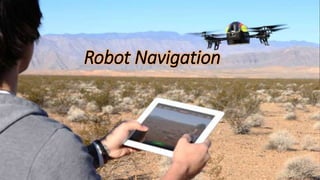
Robotics Navigation
- 2. Introduction • In the first step we get familiar with basic concepts of 2D geometry • Then we apply our perspective to obtain practical results to obtain robots motion and pose • And finally we present the most basic robot problem and how to approach and solving it
- 3. 2D Geometry • Cartesian coordinates: 𝒙 = 𝑥 𝑦 • Augmented vector: 𝒙 = 𝑥 𝑦 1 • Homogeneous coordinates: 𝒙 = 𝑥 𝑦 𝜔 = 𝜔 𝑥 𝜔 𝑦 𝜔 1 • Points at 𝜔 = 0 represent infinity
- 4. Primitive operations in 2D geometry • To represent a line we need an offset from the origin and a direction • Mathematical representation is in the following form: • 𝐼 = ( 𝑎 𝑏 𝑐) 𝑇 • 𝑥. 𝐼 = ax + by + c =0
- 5. Intersection of two lines Line joining two points : 𝐼 = 𝑥1 x 𝑥2 Point of intersection : 𝑥 = 𝐼1 x 𝐼2
- 6. 2D transformation We see how the homogeneous coordinate system simplifies the transformation operations
- 8. Robot Example Robot is located somewhere in space Position : x , y Orientation : 𝜓 (yaw angle) X = 𝑅 𝑡 0 1 = cos 𝜓 − sin 𝜓 𝑥 sin 𝜓 cos 𝜓 𝑦 0 0 1
- 9. Robot pose Robot is located in X = 0.7 Y = 0.5 𝜓 = 45 𝜊 Position matrix: X = cos 45 − sin 45 0.7 sin 45 cos 45 0.5 0 0 1 = 0.71 −0.71 0.7 0.71 0.71 0.5 0 0 1
- 10. What happens if we move the robot 1m forward? The resulting coordinate on global frame is: 𝑃𝑔𝑙𝑜𝑏𝑎𝑙 = X 𝑃𝑙𝑜𝑐𝑎𝑙 => 0.71 −0.71 0.7 0.71 0.71 0.5 0 0 1 1 0 1 = 1.41 1.21 1 From homogeneous coordinates we have: 𝑃𝑙𝑜𝑐𝑎𝑙 = 1 0 1
- 11. What happens if robot moves 0.2m forward , 0.1m sideward and turn by 10 degrees We obtain transformation matrix in previous manner U = cos 10 − sin 10 0.2 sin 10 cos 10 0.1 0 0 1 = 0.98 −0.17 0.2 0.17 0.98 0.1 0 0 1 Now multiplying by pose matrix 𝑥 = XU = 0.71 −0.71 0.7 0.71 0.71 0.5 0 0 1 0.98 −0.17 0.2 0.17 0.98 0.1 0 0 1
- 12. Estimating robots motion(Odometry) • We know what commands are issued to the robot • Based on our commands we predict the robots motion • Three main methods are used depending on robots application • 1.control based :models predict the estimated motion • 2.odometry based :distance sensors estimate the motion(e.g., wheeled robots) • 3.velocity based : velocity sensors estimate the motion(flying robots)
- 13. Motion models • Integrating IMU readings results in motion of robot • IMU readings are sensor outputs with a certain frequency (e.g., 200hz). • Estimating robot pose 𝑥 𝑡 based on issued controls (IMU readings) 𝑢 𝑡 and the previous location 𝑥 𝑡−1 • Motion model 𝑥 𝑡 = f(𝑥 𝑡−1 , 𝑢 𝑡)
